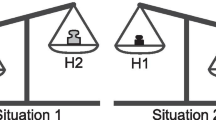Abstract
One of the central questions in a legal trial is whether the suspect did or did not commit the crime. It will be apparent that absolute certainty cannot be attained. Because there is always a certain degree of uncertainty when interpreting the evidence, none of the evidence rules out all hypotheses except one. The central question should therefore be formulated in terms of probability. For instance, how probable is it that the suspect is the offender, given the situation and a number of inherent uncertain pieces of evidence? The answer to this question requires the estimation, and subsequent combination, of all relevant probabilities, and cannot be provided by the forensic expert. What the forensic expert can provide is just a piece of the puzzle: an estimate of the evidential value of her investigation. This evidential value is based on estimates of the probabilities of the evidence given at least two prespecified hypotheses. These probabilities can subsequently be used by the legal decision maker in order to determine an answer to the question above, but they are, of course, not sufficient. They need to be combined with all the other information in the case. A probabilistic framework to do this is the Likelihood Ratio approach for the interpretation of forensic evidence. In this chapter we will describe this framework.
Access this chapter
Tax calculation will be finalised at checkout
Purchases are for personal use only
Similar content being viewed by others
References
Aitken CGG, Taroni F (2004) Statistics and the evaluation of evidence for forensic scientists, 2nd edn. Wiley, Chichester
Bayes T, Price R (1763) An essay towards solving a problem in the doctrine of chance. By the late Rev. Mr. Bayes, communicated by Mr. Price, in a letter to John Canton, M. A. and F. R. S. Philos Trans R Soc Lond 53: 370–418
Brown LD, Cai T, DasGupta A (2001) Interval estimation for a binomial proportion (with discussion). Stat Sci 16:101–133
Buckleton J, Triggs CM, Walsh SJ (eds) (2005) Forensic DNA evidence interpretation. CRC, Boca Raton
Colyvan M, Regan HM (2007) Legal decisions and the reference class problem. Int J Evidence Proof 11:274–285
Cook R, Evett IW, Jackson G, Jones PJ, Lambert JA (1998) A hierarchy of propositions: deciding which level to address in casework. Sci Justice 38:231–239
Curran JM (2005) An introduction to Bayesian credible intervals for sampling error in DNA profiles. Law Prob Risk 4:15–126
Curran JM, Buckleton JS, Triggs CM, Weir BS (2002) Assessing uncertainty in DNA evidence caused by sampling effects. Sci Justice 42:29–37
Dann RS, Koch GG (2005) Review and evaluation of methods for computing confidence intervals for the ratio of two proportions and considerations for non-inferiority clinical trials. J Biopharm Stat 15:85–107
Dror IE (2009) How can Francis Bacon help forensic science? The four idols of human biases. Jurimetrics 50:93–110
Dror IE, Cole S (2010) The vision in ‘blind’ justice: expert perception, judgment and visual cognition in forensic pattern recognition. Psychon Bull Rev 17:161–167
Dror IE, Charlton D, Peron A (2006) Contextual information renders experts vulnerable to making erroneous identifications. Forensic Sci Int 156:74–78
Evet IW (1998) Toward a uniform framework for reporting opinions in forensic science case work. Sci Justice 38:198–202
Finkelstein MO, Levin B (1990) Statistics for lawyers. Springer, New York
Gastwirth JL (ed) (2000) Statistical science in the courtroom. Springer, New York
Hall LJ, Player E (2008) Will the introduction of an emotional context affect fingerprint analysis and decision-making? Forensic Sci Int 181:36–39
Kaye DH (2010) The double helix and the law of evidence. Harvard University Press, Cambridge
Koopman PAR (1984) Confidence intervals for the ratio of two binomial proportions. Biometrics 40:513–517
Lucy D (2005) Introduction to statistics for forensic scientists. Wiley, Chichester
Morrison GS (2010) Forensic voice comparison. In: Freckelton I, Selby H (eds) Expert evidence. Thomson Reuters, Sydney
Redmayne M (2001) Expert evidence and criminal justice. Oxford University Press, Oxford
Risinger MD, Saks MJ, Thompson WC, Rosenthal R (2002) The Daubert/Kumbo implications of observer effects in forensic science: hidden problems of expectation and suggestion. California Law Review 90:1–56
Robertson B, Vignaux GA (1995) Interpreting evidence: evaluating forensic science in the courtroom. Wiley, Chicester
Saks MJ, Koehler JJ (2005) The coming paradigm shift in forensic identification science. Science 309:892–895
Saks MJ, Risinger MD, Rosenthal R, Thompson WC (2003) Context effects in forensic science: a review and application of the science of science to crime laboratory practice in the United States. Sci Justice 43:77–90
Taroni F, Aitken CGG, Garbolino P, Biedermann A (2006) Bayesian networks and probabilistic inference in forensic science. Wiley, Chichester
Taroni F, Bozza S, Biedermann A, Garbolino P, Aitken CGG (2010) Data analysis in forensic science: a Bayesian decision perspective. Wiley, Chichester
Thompson WC (2009) Painting the target around the matching profile: the Texas sharpshooter fallacy in forensic DNA interpretation. Law Prob Risk 8:257–276
Thompson WC, Schuman EL (1987) Interpretation of statistical evidence in criminal trials-the prosecutor’s fallacy and the defense attorney’s fallacy. Law Hum Behav 11:167–187
Author information
Authors and Affiliations
Corresponding authors
Editor information
Editors and Affiliations
Rights and permissions
Copyright information
© 2012 Springer Science+Business Media B.V.
About this entry
Cite this entry
Stoel, R.D., Sjerps, M. (2012). Interpretation of Forensic Evidence. In: Roeser, S., Hillerbrand, R., Sandin, P., Peterson, M. (eds) Handbook of Risk Theory. Springer, Dordrecht. https://doi.org/10.1007/978-94-007-1433-5_6
Download citation
DOI: https://doi.org/10.1007/978-94-007-1433-5_6
Publisher Name: Springer, Dordrecht
Print ISBN: 978-94-007-1432-8
Online ISBN: 978-94-007-1433-5
eBook Packages: Humanities, Social Sciences and Law




